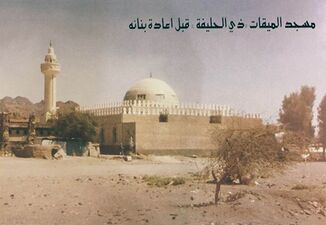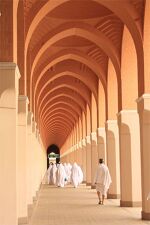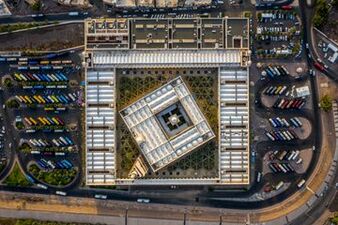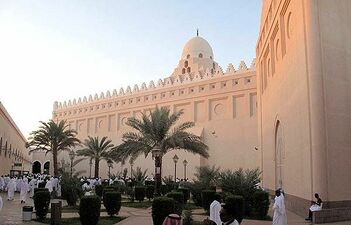Al-Shajara Mosque
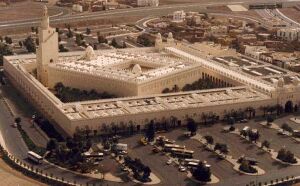 | |
| General Information | |
|---|---|
| Place | Dhul-Hulayfa near Medina |
| Usage | Mosque, Miqat |
| Religious Aspect | |
| Religious Affiliation | Islam |
| Rulings | The people of Medina wear Ihram from this place. |
Al-Shajara Mosque (المسجد الشجرة) in Medina is one of the five Miqats. This place is the Miqat for the people of Medina and those who travel from Medina to Mecca. It is said that the Prophet of Islam, peace be upon him, would don the ihram from this location when he set out for Hajj. Dhul Hulayfa, Miqat Mosque, and Abar Ali are other names for this mosque. According to historians, the Masjid Shajara was built during the caliphate of Umar b. Khattab and has been reconstructed several times since then. Today, the Shajara mosque is located about three kilometers from Medina, near the Medina-Mecca highway.
location
Shajara mosque is one of the historical mosques of Medina.[1] And it is located about eight kilometers south of this city.[2] The Prophet of Islam would don the ihram from this mosque for performing Hajj and Umra.[3] Imam Ali(S) took the verses of dissociation from Abu Bakr, the first caliph, at this place and proclaimed them to the polytheists in Mecca.[4] According to a report, there is another mosque with the same name in Mecca that is among the oldest mosques in that city.[5]
Names
This mosque is called Shajara mosque because there was a tree there under whose shade the Prophet would sit.[6] The mosque has been built in an area called Dhul-Hulayfa. This area is also known as Abar or Abiar Ali and is attributed to Ali b. Abi Talib. Consequently, this mosque is also known by the names Masjid Dhul-Hulayfa and Masjid Abar Ali or Bi’r Ali. Additionally, it is popularly referred to by the locals as Masjid Ihram and Masjid Miqat. It is also called Masjid al-Husa.[7]
The construction date
The original construction of this mosque is very ancient. Some historians, based on documents, have also mentioned that the mosque was built in the early decades of Islamic history.[8] Historians speculate that this mosque was first built during the governorship of Umar b. Abdul-aziz over Medina, between the years 87-93 AH/706- 711-12.[9]
Ninth century reconstruction
According to Matari (d. 741 AH/1340-1), the old structure of this mosque, which was a large building, had become partially ruined by his time (the first half of the 8th century).[10] However, according to Samhudi (a historian of Medina who died in 911 AH/1505-6), the mosque was reconstructed in the year 861 AH/1456-7 based on its original structure.[11]
fourteenth centuryReconstruction
It is said that this mosque was built in the late 11th century.[12] It was destroyed, and a Muslim from India, in the year 1090 AH/1679-80, with the permission of the Ottoman government, reconstructed it.[13] Hisam al-Saltana, who saw this mosque in the year 1298 AH/1880-1, described it as follows: 'The mentioned mosque is square and fifty-two cubits in length. It is made of stone and plaster. On the south side, there is a porch over which an arch is placed, and its dome has been whitened from the outside, and there is a mihrab in the middle of it.[14] Ayyashi, in a report about his first trip in the year 1353 AH/1934-5, writes about this mosque: 'A rectangular building made of mudbrick and mud, with a roof made of date palm wood and leaves, which caught the attention of the officials of the time and was expanded.[15]
The current state
This mosque was reconstructed once during the era of the Al Saud in the year 1375 AH / 1955 AD.[16] And a minaret was built for it[17] The mosque was reconstructed and expanded again in the year 1408 AH / 1988 AD.[18] Facilities such as baths, toilets, parking, a market, and a restaurant were built around it. The total area of the mosque along with its surroundings reaches 290,000 square meters, of which the mosque building and its associated buildings comprise 226,000 square meters.[19]
Miqaat for Hajj
Shajara mosque is one of the Miqats for Hajj.[20] According to some historians, when the Prophet(s) was setting out for Mecca to perform the Hajj, he would enter into the state of Ihram at this place.[21] Jurists consider Masjid al-Shajarah as one of the five Miqats for Hajj and believe that it is the Miqat for the people of Medina and those who travel from this city to Mecca.[22]
The necessity of the people of Medina to enter Ihram at Shajara mosque
According to the prevalent opinion among Shia jurists, residents of Medina must enter Ihram at Shajara mosque, and it is not permissible for them to leave the Miqat of Shajara mosque without entering Ihram and go to another Miqat like Juhfa to enter Ihram there.[23] Only for those who are excused (incapacitated or ill), is it permissible to enter Ihram from Juhfa.[24] It has also been stated that this ruling applies to those who go from Medina to Dhul Hulayfa and pass through without entering Ihram and reach Juhfa; however, if they do not pass through Dhul-Hulayfa and exit via another route to another Miqat,[Explanatory Notes 1] there is no issue, because passing through the Miqat in this manner is not conventionally considered crossing the Miqat.[25]
The exact location of the Miqat
Dhul Hulayfa was the name of a large area where Shajara mosque was located.[26] In narratives, sometimes Shajara mosque is referred to as the Miqat for the Hajj of the people of Medina, and sometimes only the terms 'Shajara' or 'Dhul Hulayfa' are used.[27] Some believe that entering into Ihram is only valid inside Shajara mosque, while others consider it valid to enter Ihram outside the mosque but still in its vicinity.[28]
Gallery
Notes
- ↑ Ṣabrī Pāshā, Mawsūʿa mirʾāt al-ḥaramayn, vol. 4, p. 811.
- ↑ Ibn Najīm, Al-Baḥr al-rāʾiq, vol. 2, p. 341.
- ↑ Ṣabrī Pāshā, Mawsūʿa mirʾāt al-ḥaramayn, vol. 4, p. 811.
- ↑ A group of authors. dānishnāma-yi kalām islāmī, vol. 1, p. 77.
- ↑ Qāʾidān, Tārīkh wa āthār-i Islāmī-yi Makka wa Madīna, vol. 1, p. 118.
- ↑ Samhūdī, Wafāʾ al-wafā bi akhbār dar al-Muṣṭafā , vol. 3, p. 421.
- ↑ Kaʿakī, Ma ʿālim al-madina al-munawwara bayn al-ʿMārat wa al-Tārīkh, vol. 4, p. 485-487.
- ↑ Najafī, Madīna shināsī, vol. 1, p. 183.
- ↑ Kaʿakī, Ma ʿālim al-madina al-munawwara bayn al-ʿMārat wa al-Tārīkh, vol. 4, p. 496.
- ↑ Maṭarī,Al-Taʿrīf bimā ʾānasat al-hijra min maʿālim dār al-hijra, p. 190.
- ↑ Samhūdī, Wafāʾ al-wafā bi akhbār dar al-Muṣṭafā , vol. 3, p. 424.
- ↑ Najafī, Madīna shināsī, vol. 1, p. 184.
- ↑ ʿAbd al-Ghanī, Al-masajid al-atharīyya fī al-madīna al-nabawīyya, p. 258.
- ↑ Sulṭān Murād Mīrzā Ḥisām al-salṭana,Safarnāma makka, p. 139.
- ↑ ʿAbd al-Ghanī, Al-masajid al-atharīyya fī al-madīna al-nabawīyya, p. 258.
- ↑ Najafī, Madīna shināsī, vol. 1, p. 184.
- ↑ ʿAbd al-Ghanī, Al-masajid al-atharīyya fī al-madīna al-nabawīyya, p. 258; Kaʿakī, Ma ʿālim al-madina al-munawwara bayn al-ʿMārat wa al-Tārīkh, vol. 4, p. 498.
- ↑ Qāʾidān, Tārīkh wa āthār-i Islāmī-yi Makka wa Madīna, vol. 1, p. 277; ʿAbd al-Ghanī, Al-masajid al-atharīyya fī al-madīna al-nabawīyya, p. 259.
- ↑ ʿAbd al-Ghanī, Al-masajid al-atharīyya fī al-madīna al-nabawīyya, p. 260.
- ↑ Kulaynī,Al-Kāfī, vol. 4, p. 319.
- ↑ Qāʾidān, Tārīkh wa āthār-i Islāmī-yi Makka wa Madīna, vol. 1, p. 275.
- ↑ Shāhrūdī, Farhang-i fiqh muṭābiq bā madhhab-i Ahl al-Bayt, vol. 3, p. 712.
- ↑ Whose duty is Ihram from Jufah? p. 64-65.
- ↑ Whose duty is Ihram from Jufah? p. 75.
- ↑ Whose duty is Ihram from Jufah? p. 65.
- ↑ Miqat on the way of Medina, p. 61.
- ↑ Fāḍil Lankarāni, Tafṣīl al-sharīʿa fī sharḥ Taḥrīr al-waṣīla, vol. 3, p. 20-24.
- ↑ Miqat on the way of Medina, p. 62.
- ↑ For example, he can fly from Medina to Jeddah and from there to Juhfa, or he can go from Medina to Dhul Hulayfa and before passing through there, he will return to medina and go to mecca from another miqat.
References
- Abū Ṣalāḥ Ḥalabī, Taqī al-Dīn b. Najm al-Dīn. Al-Kāfī fī al-fiqh. Isfahan: Maktaba Imam Amīr al-Muʾminīn (a), 1403 AH.
- ʿAbd al-Ghanī, Muḥammad Ilyās.Al-masajid al-atharīyya fī al-madīna al-nabawīyya. Madina: Maṭābiʿ al-Rashīd, 1419 AH.
- A group of authors. dānishnāma-yi kalām islāmī. Qom: Muʾassasat Imām al-Ṣādiq, 1388 sh.
- Barikat Riḍāʾī, Rūzbih. Whose duty is Ihram from Jufah?. Miqat Hajj quarterly, Num. 96, Tir 1395 sh.
- Fāḍil Lankarāni, Muḥammad. Tafṣīl al-sharīʿa fī sharḥ Taḥrīr al-waṣīla.Beirut: Dār al-Taʿāruf li-l-Maṭbūʿāt, 1418 AH.
- Ḥillī, Ibn Idrīs al-. Kitāb al-sarāʾir al-ḥāwī li taḥrīr al-fatāwī. Qom: Daftar-i Intishārāt-i Islāmī, 1410 AH.
- Ibn Diyāʾ al-Makkī, Muḥammad b. Aḥmad. Tārīkh Makka al-musharrafa wa al-Masjid al-ḥarām wa al-Madīna al-sharīfa wa al-qabr al-sharīf. Edited by ʿAla Ibrāhīm Azharī and Īman Naṣr. Beirut: 1424 AH.
- Ibn Najīm, Zayn al-Dīn al-Ḥanafī. Al-Baḥr al-rāʾiq: sharḥ-i kanz al-daqāʾiq. Beirut: Dār al-Kutub al-ʿIlmiyya,1418 AH.
- Jaʿfariyān, Rasūl. Āthār-i islāmi-yi Makka wa Madīna. Tehran: Mashʿar, 1382 Sh.
- Kaʿakī, ʿAbd al-ʿAzīz b. ʿAbd al-Raḥmān. Ma ʿālim al-madina al-munawwara bayn al-ʿMārat wa al-Tārīkh. Beirut: Dār wa maktabat al-hilāl, 2011.
- Kulaynī, Muḥammad b. Yaʿqūb al-. Al-Kāfī. Edited by ʿAlī Akbar Ghaffārī & Muḥammad Ākhūndī. Tehran: Dār al-Kutub al-Islāmīyya, 1407 AH.
- Maṭarī, Muḥammad b. Aḥmad al-. Al-Taʿrīf bimā ʾānasat al-hijra min maʿālim dār al-hijra. Riyadh: Dār al-malik ʿAbdu-l ʿAzīz, 2005.
- Mufīd, Muḥammad b. Muḥammad al-. Al-Muqniʿa. Qom: Kungira-yi Shaykh al-Mufīd, 1413 AH.
- Mūsawī Shāhrūdī, Sayyid Murtaḍā. Miqat on the way of Medina. Miqat Hajj quarterly, Num. 68, Summer 1388 sh.
- Najafī, Sayyid Muḥammad Bāqir. Madīna shināsī. Tehran: Mashʿar, 1387 sh.
- Qāʾidān, Aṣghar. Tārīkh wa āthār-i Islāmī-yi Makka wa Madīna. 4th edition. Qom: Nashr-i Mashʿar, 1381 Sh.
- Ṣabrī Pāshā, Ayyūb. Mawsūʿa mirʾāt al-ḥaramayn. Cairo: Shirkat al-Dawlīyya li-l-Ṭibāʿa, 2004.
- Ṣadūq, Muḥammad b. ʿAlī al-. Al-Muqniʿ fī al-fiqh. Qom: Muʾassasa al-Imām al-Hādī, 1415 AH.
- Samhūdī, ʿAlī b. ʿAbd Allāh. Wafāʾ al-wafā bi akhbār dar al-Muṣṭafā. Edited by Muḥammad Muḥyi al-Dīn ʿAbd al-Ḥamīd. Beirut: 1984.
- Sayyid Murtaḍā, ʿAlī b. Ḥusayn. Al-Masāʾil al-nāṣirīyyāt. First edition. Tehran: Rābitat al-Thiqāfa wa l-ʿAlāqāt al-Islāmiyya, 1417 AH.
- Shāhrūdī, Sayyid Maḥmūd. Farhang-i fiqh muṭābiq bā madhhab-i Ahl al-Bayt. Qom: Muʾassasat Dāʾirat al-Maʿārif al-Fiqh al-Islāmī, 1387 Sh.
- Sulṭān Murād Mīrzā Ḥisām al-salṭana .Safarnāma makka. Edited by Rasūl Jaʿfarīyān, Tehran: Mashʿar, 1374 sh.
- Ṭūsī, Muḥammad b. al-Ḥasan al-. Al-Nihāya fī mujarrad al-fiqh wa al-fatāwā. Beirut: Dār al-Kutub al-ʿArabiyya, 1400 AH.
